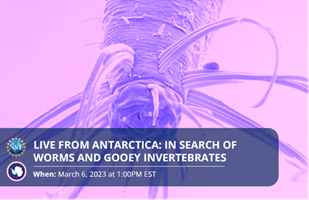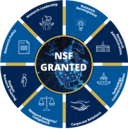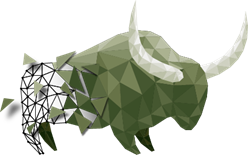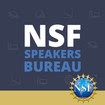 Dear NSF Community, Welcome back to another issue of NSF Quarterly: News from the Director. The "CHIPS and Science Act" set out a bold vision for NSF, and a historic investment in the Fiscal Year 2023 appropriations puts NSF on a trajectory to realize it. At $9.9 billion, it is our largest percentage increase in more than two decades and our largest dollar increase ever. The landmark act codified NSF's first new directorate in more than 30 years: Technology, Innovation and Partnerships, or TIP. By connecting teams of researchers, practitioners and users across the country and around the globe, TIP is driving new research directions, bringing game-changing technologies and impactful solutions to market faster, and growing a broad future workforce. The spirit of innovation permeates everything we do across NSF. Now, with TIP, we can leverage those efforts and take them to the next level. It is exciting to see that this type of bold innovation is not just happening at NSF. I recently traveled to Kansas to visit the National Institute for Aviation Research at Wichita State University; the National Center for Aviation Training at WSU Tech; and the National Institute for Materials Advancement at Pittsburg State University. These institutions are inspiring the next-generation STEM workforce and spurring innovation anywhere through a fusion of research, education and training. After my visit to Kansas, I had a chance to tour Virginia Commonwealth University. From experiencing the Virginia Microelectronics Center to the Nanomaterials Core Characterization Facility, my tour at VCU showcased that when researchers, faculty and students work side by side, bold, transformative approaches to STEM education training are unlocked. Today, emerging technologies such as quantum computing, wireless, and artificial intelligence are transforming research, industry and society like never before. To remain at the vanguard of science and technology, we must address two urgent challenges facing our nation: - We must create more opportunities for everyone and anyone to participate in the STEM enterprise (all ethnicities and geographic areas).
- We must develop a robust STEM workforce to bolster our innovative capacity.
To do this, we are continuing to scale investments to unleash the full potential of talent and ideas that exist throughout the United States. Our nation's vast diversity is our greatest competitive advantage. Our new Growing Research Access for Nationally Transformative Equity and Diversity, or GRANTED, initiative sets out to do just that. Too often, the workforce that makes up the research enterprise comes together by chance and their access to training or career support varies. However, we know that these individuals play a vital role in securing the research investments needed to power scientific breakthroughs and groundbreaking innovation. NSF's GRANTED will be instrumental in supporting critical research enterprise workforce capacity building at a national level by making the positions, skills and knowledge needed to build a robust research infrastructure broadly inclusive and accessible to institutions of all sizes and resources, empowering researchers across the country. Innovation can happen anywhere when we enable opportunity everywhere. Sincerely, |
 | |
Sethuraman Panchanathan
Director, National Science Foundation
|
|
|
The rapid retreat of Thwaites Glacier in West Antarctica appears to be driven by processes under its floating ice shelf that are different than researchers realized. Two papers published in the journal Nature provide a clearer picture of the changes taking place under the glacier, which is the size of Florida and is one of the fastest-changing ice-ocean systems in Antarctica. Read more ... 
The U.S. National Science Foundation today announced the Accelerating Research Translation, or ART, program, a new $60 million investment led by NSF's Directorate for Technology, Innovation and Partnerships. The program will support institutions of higher education to build capacity and infrastructure needed to strengthen and scale the translation of basic research outcomes into impactful solutions and practice. Read more ... 
That magnet on your refrigerator? Let's supersize it. Imagine it's 1 million times more powerful than Earth's magnetic field and as heavy as a small herd of elephants. Imagine it's powerful enough to image not just the organs but the individual cells in your body. Read more ... 
The quantum future is on our doorstep — and the U.S. National Science Foundation is helping to bring it home. For years, NSF has invested in quantum education, research, discovery, innovation and a quantum-ready workforce. Breakthroughs in quantum promise tantalizing advances in computing, health care, energy, communications and industrial materials – and it will make us more secure as a society and a nation. Read more ... 
At the center of the Milky Way is a supermassive black hole 4.3 million times bigger than the sun known as Sagittarius A*. Until recently, it was not clear how much of the matter at the heart of the galaxy was Sagittarius A*. Astronomers measured the velocities of four distant stars around the black hole. The movement of the stars indicates the mass at the galaxy’s center is composed almost entirely of matter from Sagittarius A*, leaving little room for stars, other black holes, interstellar dust and gas, or dark matter. Read more ...
Want more? From Earth’s poles to black holes, read more NSF stories about transforming the world through science.
|
|
 Join this question-and-answer session to learn more about America's Seed Fund powered by NSF. A Small Business Innovation Research/Small Business Technology Transfer (SBIR/STTR) program director will answer questions about how to get started, the basics of eligibility and what they look for when they review project pitches. Upcoming office hours will run from 2:00–3:00 p.m. ET on March 2, March 16, March 30, and April 13, 2023. Learn more and register. |
 The Antarctic continental shelf is one of the most remote and understudied marine ecosystems on Earth. The seafloor here is teeming with invertebrate life: worm species large and small, microscopic mollusks, sea spiders, sea stars and sea cucumbers (oh my!), all coexisting together on the vast muddy bottom. Join a team of invertebrate taxonomists and evolutionary biologists searching for new species around Eastern Antarctica. They'll give you a quick tour of their deep-sea research ship, answer your questions about their work and more on March 6 at 1:00 p.m. ET. Register today! |
 Do you want to know more about NSF's new Growing Access for Nationally Transformative Equity and Diversity, or GRANTED, initiative? Are you thinking about applying to our most recent Dear Colleague Letter? Then we invite you to GRANTED office hours, held every Wednesday from 3:00–4:00 p.m. ET, to meet with the GRANTED team of program directors. Learn more and access the Zoom link. |
Search and save the date for other upcoming NSF events.
|
|
 Following the interest in cordyceps spurred by the hit television series "The Last of Us," NSF mycologist Dr. Cathy Aimee delves into the fascinating world of cordyceps. In this video, she explains how the spore of a cordycep comes into contact with its host, penetrates and begins to fill and grow the host cavity, and ultimately digests the nonessential parts of the host. Cordyceps aren't all horror though. In this video, Dr. Andrea Porras-Alfaro, an NSF microbial ecologist, shares the surprising benefits of cordyceps and explains how fungi are extremely important in the environment. |
 The NSF-supported Idaho Museum of Natural History has developed a website that provides full open-access to 3D models and images of their treasures. They have a wide range of fossils, bones and cultural artifacts from their museum and other institutions across North America. Come back often to see new material as they continue to scan and upload models. Visit today! |
 Our science-loving staff want to share their passion and knowledge with you. NSF speakers offer a wealth of knowledge and subject matter expertise in a broad range of science, engineering and STEM research and education topics. Request an NSF speaker to inspire your audience at your next event today! |
|
|
Supports research that incorporates scientific insights about human behavior and social dynamics to better design, develop, rehabilitate and maintain strong and effective American infrastructure. Full proposal due March 15, 2023. NSF, in partnership with the American Association of Community Colleges, is accepting submissions to the annual CCIC prize competition, designed to enable community college students to discover and demonstrate their capacity to use STEM to make a difference in the world and to translate that knowledge into action. Submissions due March 30, 2023, at 11:59 p.m. PDT. Supports the development of a just, equitable and inclusive geoscience research community via projects that are based on education scholarship, mentorship, allyship, equity, anti-racist and anti-harassment practices, and increasing accessibility. Full proposal due April 3, 2023. The program seeks to grow a broad coalition of researchers and educators from across science and engineering communities that utilize a holistic, co-design approach to fundamental research and workforce education and training, enabling rapid progress in new semiconductor technologies. Full proposal due April 24, 2023. This Dear Colleague Letter encourages the sustainable development and use of open-source software, tools, libraries and frameworks that are critical for polar scientific objectives. Proposals which support the opening, documenting and sharing of open polar research software/code are encouraged. New proposals will be accepted by May 1, 2023, and applications for supplemental funding will be accepted anytime. NSF is in the process of updating its Public Access Policy, with a plan slated for release in May of 2023. NSF is also playing a leadership role with other federal agencies in celebrating 2023, the Year of Open Science. Help NSF celebrate the Year of Open Science by downloading these virtual backgrounds. ART Supports institutions of higher education that seek to build capacity and infrastructure for translation of fundamental academic research into tangible solutions that benefit the public. Full proposal due May 9, 2023. The National Medal of Science is the highest recognition the nation can bestow on scientists and engineers. You can now nominate a peer or colleague deserving of special recognition because of their outstanding cumulative contributions to knowledge in the physical, biological, mathematical, engineering, or behavioral or social sciences, in service to the nation. Nominations due by May 26, 2023. Supports pre-tenure faculty in the biological sciences at institutions that traditionally do not receive significant NSF funding in this field, including minority-serving institutions, predominantly undergraduate institutions and R2 institutions. Full proposal submission window: June 1-June 30, 2023. Supports postdoctoral research in the social, behavioral and economic sciences and/or activities that broaden the participation of underrepresented groups in these fields. Full proposal due November 1, 2023.
Search for more NSF funding opportunities in your field and check out NSF 101, our informational series for the science and engineering research community. NSF 101 answers commonly asked questions for applicants who might be new to applying for NSF funding opportunities and want to know more about how to communicate with NSF.

The U.S. National Science Foundation supports multiple programs for high school, undergraduate and post-baccalaureate students to help fund research opportunities. There are several ways to find these programs, including the funding search on NSF's website and the NSF Education & Training Application, or ETAP. Read more ... |
|
| |
|














